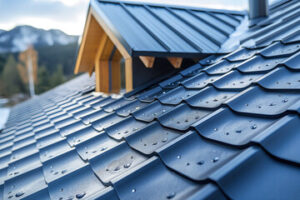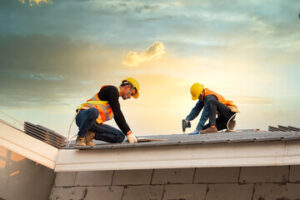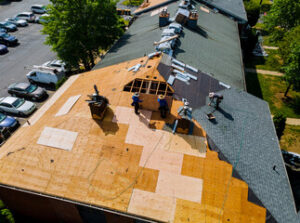Roof inspections are a key part of any maintenance program. These help to identify any damage or potential issues such as water stains on the ceilings or a leaky roof. Inspectors will also look for caulking or sealing around penetration points like vent pipes, chimneys, and skylights.
Performing general roof maintenance on a regular basis will prevent issues from becoming worse and protects the value of your home. This includes cleaning gutters, trimming overhanging branches, and a roof inspection twice a year. Visit https://www.fivestarroofingandcontracting.com/ to learn more.

Clean debris from your roof regularly to prevent clogging, excess moisture, and other damage. This task is often difficult to perform and requires a ladder or other climbing equipment, so it’s important to only do this when the weather and conditions allow for safe work.
Debris includes organic material like leaves, pine needles, and twigs as well as inorganic items like garbage. This material can clog gutters, leading to water overflow and potential roof leaks. It can also retain moisture, causing mold and rot. Finally, it can attract pests and other unwanted guests to your home.
Annual roof cleaning is a great way to reduce the risk of these problems and to improve your home’s curb appeal. To safely remove debris from the roof, use a sturdy ladder with safety stabilizers and non-slip shoes. A roof rake or broom with a long handle can help you reach more difficult areas without damaging the roof surface.
Start at the lowest point of your roof and work your way up, carefully removing loose debris and collecting it in a trash bag or tarp as you go. If you have a leaf blower, it can help speed up the process and make it easier to reach difficult areas. Once you have removed all the loose debris, rinse the entire roof with a garden hose to wash away any residual cleaning solution and to prevent water runoff.
If you notice stains, spray or scrub the area with a hose and soft brush or broom. If the stains are caused by moss or algae, a pre-mixed moss remover or bleach and water mixture can be used to kill the growth. This will help prevent regrowth and extend the life of your roof.
During this time, it’s also important to inspect the roof for any damage that needs to be repaired. You should also check the condition of flashing, caulking, and sealants around penetrations and vents. If these materials are damaged, they will need to be replaced to ensure a watertight seal. This should be done by a roofing professional to avoid causing further damage or leaking.
Inspect and Replace Flashing
Flashing is the material that seals joints and transitions on a roof, including around chimneys, vents, and skylights. It is important to inspect roof flashing regularly and to make repairs as needed, to avoid water leaks and other damage to the home.
Common problems with roof flashing include loose or bent flashing, which may no longer provide a tight seal, as well as cracked or broken flashing. In addition, rust or corrosion on metal flashings can deteriorate the material, allowing water to penetrate the roof and cause serious interior damage.
Checking for these issues is easy with a good roof inspection. Look for dents and bends, as well as cracks or breaks, particularly in the areas where the flashing meets the shingles or walls of the house. The flashing should overlap the shingles properly and extend past them, providing a waterproof barrier.
If you notice any signs of flashing problems, it’s a good idea to hire a roofing professional for a complete roof assessment and repair as soon as possible. This can help prevent costly roof repair and water damage to your home.
While it is possible to repair some flashing issues without removing the shingles or tiles on the roof, this is not recommended for novices and should only be undertaken by a trained professional. If you do decide to perform a flashing repair yourself, take the proper safety precautions, such as using ladders with secure footing and wearing gloves, goggles, and sturdy work boots.
You should also clean the work area before starting any work on your roof, to prevent debris and mud from getting into cracks or holes in the flashing. You should also use a ladder with secure handrails and ensure that it is securely fastened to the joists of the house. Finally, if you use a caulking or roofing cement to seal any gaps or repairs, be sure to remove any leftover material and residue before the next inspection to prevent moisture intrusion. A reputable roofing company will have the tools and equipment necessary to conduct these kinds of repairs and will be able to offer helpful guidance on the process.
Reapply Sealants or Coatings
While examining your roof, you might notice areas where the caulking has begun to break down or dry. This is a common problem and reapplying the sealant can help prevent water leaks. However, it is important to remove all debris and dirt from the area before applying a new layer of caulking to ensure that the concrete surface can adhere properly.
Another area where the roof should be inspected regularly is the flashing around chimneys, vent pipes, skylights and other openings in the roof. These pieces of metal or other material seal off the joints in the roof and are particularly vulnerable to water leaks because they move with the weather. Replacing any rusty or damaged flashing and re-caulking as needed helps keep the water from leaking into your home. It is best to leave these tasks to a professional since working on your roof can be dangerous and may void some manufacturers’ warranties.
Inspecting soffits, fascia and downspouts is also important because they are designed to facilitate airflow and water drainage. They need to be free of holes, cracks and peeling paint to function properly. Additionally, it is a good idea to clean out your gutters often. Clogged gutters allow water to back up and seep under your roof causing rot and leaks.
Removing moss and algae is also necessary for proper roof maintenance. These organisms can lift shingles and cause damage to the roof and insulation. Regularly cleaning the shingles and removing these growths can prevent them from getting worse over time.
Other items that need to be checked regularly include ponding areas, which are water pools on the roof surface, and attic insulation. If the attic has poor insulation, it will lose heat and increase your energy bills. Additionally, ponding water can cause the surface to breakdown over time, so it is important to address this as soon as possible. There are a variety of different Karnak materials that can be used to resist the breakdown of surfaces in ponding areas, such as acrylic coatings and silicone.
Trim Trees
While it is impossible to stop tree growth entirely, a regular trimming schedule reduces the risk of damage caused by branches falling during heavy storms. In addition, trimmed trees help prevent the accumulation of organic matter and pests on the roof.
Untrimmed trees create safety hazards by extending over the roof and potentially impacting it or the people on it during storms. They also obstruct sunlight, which can lead to moisture buildup and deteriorate roof materials. Moisture buildup and decay can significantly shorten the lifespan of roofing materials.
Additionally, if the roof is impacted by a falling tree branch, it can cause significant structural damage to the home and increase the cost of repairs. The best way to avoid this is by regularly monitoring the condition of nearby trees and keeping them trimmed as needed.
Branches that extend close to the roof can scrape or puncture the surface of metal roofing. It is recommended that homeowners trim tree limbs within 6 feet of the roof line. This prevents abrasion and reduces the chance of puncture by debris during storms.
In addition to protecting the roof, properly trimmed trees enhance property value by showcasing attractive species and maintaining healthy bark. In addition, trimmed limbs allow more sunlight to reach the roof, reducing the risk of mold and minimizing the need for costly repairs and replacements.
If you are concerned about a tree or are interested in having it trimmed, call the experts at Legacy Roofing to learn more about our maintenance programs. Our experienced team can safely and effectively assess the health of your roof and surrounding trees, helping you minimize the risk of damage or pest infestation while preserving the beauty and value of your property.
While it may seem tempting to save money by performing your own tree trimming, it is a dangerous job that should be left to professionals. A small mistake could result in a fall and severe injuries or property damage. It is also important to check with your arborist and local city bylaws before removing an unstable or ill-healthy tree.

